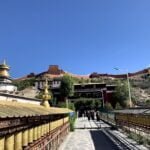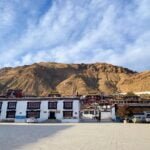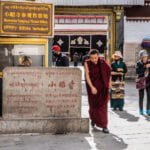Unveiling the Shalu Temple’s Remarkable History and Architecture
The Shalu Temple, nestled in the heart of Tibet, is not just a religious site but a testament to love that transcends boundaries. This temple is renowned for its unique architectural blend, harmoniously merging Tibetan and Chinese styles. Its exquisite murals and historical significance make it a cultural gem.
A Glimpse into Shalu Temple’s Architectural Marvel
Shalu Temple proudly houses the most extensive and best-preserved Yuan Dynasty temple building in Tibet. This architectural masterpiece seamlessly integrates ancient Chinese and Tibetan architectural arts, symbolising cultural fusion. Unlike many Tibetan structures that cling to mountainsides, Shalu Temple serenely graces the mountainous terrain. This exceptional location adds to its allure, offering a distinct cultural experience.
Shalu Village: A Testament to the Temple’s Influence
Shalu Village takes its name from the temple that has shaped its identity. The entire village revolves around the presence of Shalu Temple, which has become an inseparable part of its cultural heritage. Embark on a journey to Shalu Temple, where history, architecture, and culture converge to create a unique and enriching experience. Explore its rich history, awe-inspiring architecture, and the captivating stories that make it a treasure trove of Tibetan heritage.
The Resilience of Tibetan Buddhism: The Story of Shalu Temple
Reviving Buddhism in Tibet
In the mid-9th century AD, Tibet encountered a dark period as Zanpu Lang Darma Dama, the ruler of the Tubo Dynasty, nearly eradicated Buddhism. However, the indomitable spirit of Buddhism refused to succumb. Around 936 AD, a group of remarkable individuals from Uzang embarked on a journey to study Buddhism in the Xia Luduomaitandi region, thousands of miles away. After years of rigorous study, they returned to Uizang around AD 975 to teach Buddhism and pass on their knowledge. This marked the revival of Buddhism in Utsang, which later evolved into Tibetan Buddhism with distinct local characteristics.
The Birth of Shalu Temple
In 997, Lodun Dorje Wangchuk, one of the ten outstanding disciples of Uizang, founded Jiangong Temple in Niangmai, Tibet’s hometown (today’s Katse area), to preach scriptures. Meanwhile, the Jie family in the Niangmai area, enriched by land income and the “Congdui” trading market, faced signs of unrest among the people they ruled. In response to the people’s needs, Jie Zun Xi Raojun, a member of the Jie family, devoted himself to Buddhism under the guidance of Lodun Dorje Wangchuk.
One day, Xi Raojun asked his teacher if he could build a temple nearby. Lodun Dorje Wangchuk agreed, and an extraordinary event occurred. Xi Raojun asked his teacher if he could build a temple within a stone’s throw of the Jiangong Monastery. His teacher agreed, and Xi Raojun stretched his bowstring and presented it to Lodun Dorje Wangchuk. The teacher, using his cane as an arrow, released the arrow, which landed in a highland barley field with newly sprouted green seedlings. This became the designated temple site, and it was named Shalu Temple, meaning “the new leaves of field crops” in Tibetan. This beautiful legend has been passed down for centuries.
The Yuan Dynasty Revival
During the Yuan Dynasty, when the central government exercised effective jurisdiction over Tibet, the region experienced stability and economic development. This period saw significant advancements in various fields, including Buddhism, calendars, medicine, astronomy, art, literature, and history. Shalu Temple, built in 1027 by Jie Zun and Xi Rao, underwent several expansions during the Yuan Dynasty. It incorporated the architectural style of glazed hilltops from inland regions and palace-style structural features of the Yuan Dynasty. The temple reached its final scale in the 14th century, featuring a unique Tibetan-Chinese architectural style.
Shalu Temple’s enduring legacy tells the story of Tibetan Buddhism’s resilience and its ability to thrive even in the face of adversity. This sacred site stands as a testament to the enduring spirit of faith and culture in Tibet.
The Yuan Dynasty and Tibet’s Transformation
The Subordination of Tibet to the Mongol Khanate
In early 1247 AD, an important meeting took place in Liangzhou, Hexi Corridor, between Sakya Pandita Kunga Gyaltsen, the leader of the Sakya Sect of Tibetan Buddhism, and the Mongolian Khanate. It was during this meeting that an agreement was reached, leading to Tibet’s subordination to the Mongol Khanate. This marked a significant turning point in Tibetan history, as it placed Tibet under the administrative jurisdiction of the central government.
The Era of Effective Central Management
Following this agreement, Tibet came under the effective management of successive central governments. Thirteen years later, in a monumental development, Kublai Khan, the founder of the Yuan Dynasty, ascended the throne. He appointed Phagpa, the successor of Sakya Pandita and the fifth leader of the Sakya sect, as the national teacher, making him the highest leader of Buddhism in the world. In the fifth year of the Yuan Dynasty (1268), the central government implemented the ten-thousand-household system in Tibet. This system included households in front of Tibet, rear of Tibet, and the Yangzhuo households in the middle, totalling 130,000 households.
The End of Separatist Rule
This marked the end of nearly 400 years of separatist rule on the Qinghai-Tibet Plateau, which had persisted since the assassination of Langdama, leading to the Tubo dynasty’s split. The scattered local leaders and separatist rulers were now appointed as magistrates under the jurisdiction of the central dynasty. This marked a significant shift in governance.
The Beginning of the Theocratic System
Under the leadership of Phagpa, who returned to Sakya, Tibet in 1276, local military and political institutions were established in Weizang. As the Dharma King of Sakya, he commanded 130,000 Tibetans. This laid the foundation for theocratic rule in Tibet. Among these households, 10,000 Shalu forever households and 10,000 Qumei households were located in Shalu Forever Village, Jiacuoxiong Township, Samzhutse District, and Qumei Township, Samzhutse District.
The Role of the Jie Family
During this transformative period, the descendants of Jie Zun Xirao Jiannai, the founder of Shalu Forever Temple, played a significant role. They were granted the title of “ancient prime minister” after forming marriages with the local government of Sakya. Kublai Khan himself recognized Aza, an ancient prime minister of the Jie family, and the Shalu Forever Wan household became the head of the Shalu Forever Wan household among the 130,000 households in the Sakya regime in Tibet. This marked the beginning of hereditary control.
Drakpa Gyaltsen’s Contributions
By the early 14th century, Drakpa Gyaltsen, another ancient prime minister of the Jie family, took the helm of the Shalu Forever Wan household. He made a pilgrimage to Emperor Yuan Renzong in Dadu, where he received a warm welcome. The emperor honoured him with a gold book and jade seal and fulfilled Drakpa Gyaltsen’s request by donating gold and silver. Han craftsmen were also dispatched to assist in the expansion of the Shalu Forever Temple.
This period of history it marked a profound transformation in Tibet’s governance and its relationship with the central Yuan Dynasty government.
The Expansion of Shalu Forever Temple
In the Iron Monkey Year (1320 AD) of the Tibetan Calendar, with the backing of the Yuan Dynasty’s central government, Drakpa Gyaltsen, the ancient prime minister of the Shalu Forever Wan household, embarked on a significant project. He invited numerous skilled Han craftsmen from the heartland of the Central Plains and collaborated with local Tibetan craftsmen in Tibet to undertake the expansion of Shalu Temple, resulting in its current size.
Unique Architectural Style
The preserved architectural style of Shalu Forever Temple stands out among Tibetan temple buildings. It represents a distinctive Tibetan-Chinese architectural complex. The main hall faces east from the west and comprises two floors. The main hall on the ground floor follows the traditional Tibetan temple architectural style, covering an area of approximately 1,500 square meters.
Distinct Han Influence
The second-story hall’s roof adheres to the traditional layout of inland Han-style temples. It consists of four main halls, side halls, and front halls, with a symmetrical arrangement on the left and right. The main hall serves as the axis, aligning with the prayer flag square in the front yard, creating a cohesive axis relationship. This design imparts a pronounced planning characteristic reminiscent of Han temples to Shalu Forever Temple.
Exquisite Glazed Roof
All four halls are adorned with glazed rooftops and cornices, covered with glazed tiles and brackets beneath the eaves. This architectural style is marked by simplicity and elegance. The glazed tiles on the roof ridges feature intricate patterns, including flying apsaras, elegant ladies, majestic lions, fierce tigers, and vibrant flowers. These patterns are exceptionally lifelike, showcasing the craftsmanship of the Yuan Dynasty.
Transfer of Glazed Tile Technology
Historical records indicate that Drakpa Gyaltsen invested significantly to bring a Han craftsman skilled in glazed tile firing from Xining. Under his guidance, local Tibetan craftsmen successfully produced glazed tiles using materials found in Shalu forever. The Han master generously shared the recipe and techniques for firing glazed tiles with the local Tibetan craftsmen, allowing Tibet to produce various glazed tiles locally. The green glazed tiles adorning the roof of Shalu Forever Temple were fired on-site under the guidance of the Han craftsman.
The dissemination of glazed tile firing technology extended to other temples in Tibet, such as the nearby Ripu Temple, where Master Butun resided in his later years. This marked the beginning of glazed decoration in Tibetan Buddhist temples and fostered the development of various arts, including murals, thangkas, clay sculptures, wood carvings, and more. These artistic traditions continue to be cherished as treasures in Tibetan culture and art.
Khenpo Butun’s Tenure
In October of the same year when the expansion of Shalu Forever Monastery was completed, Drakpa Gyaltsen invited Khenpo Butun Rinchendrup, a 31-year-old from Chopu Monastery and the third-generation descendant of the Chopu Kagyu sect of Tibetan Buddhism. He assumed the role of the 11th Khenbu of Shalu Forever Monastery. Khenpo Butun served as the head of the monastery for an impressive 30 years, leaving a lasting legacy.
The Influence of Master Butun at Shalu Forever Monastery
Master Butun’s arrival at Shalu Forever Monastery marked a significant turning point in its history. Under his guidance, the monastery flourished and gained an immense reputation, becoming one of the most prominent centres of Tibetan Buddhism.
Prolific Scholarship
Master Butun, widely regarded as the most important scholar in 14th-century Tibet, authored numerous works during his tenure at Shalu Forever Monastery. His “History of Butun Buddhism,” written in 1322, remains a fundamental reference for Tibetan scholars. Moreover, with the financial support of the Jie family, he undertook the comprehensive revision of the Nathang version of the Tripitaka “Tengyur.” This monumental project drew participation from eminent monks of all Tibetan Buddhist sects and significantly expanded the corpus of Tibetan Buddhist scriptures.
Master Butun, as the chief editor, revised and reviewed almost all Tibetan Buddhist scriptures, adding over 1,000 treatises not included in previous editions. He also compiled a comprehensive catalogue for this Tripitaka.
Multifaceted Contributions
Master Butun’s contributions extended beyond the realm of religious scholarship. He was a leader in various fields, including astronomy, medicine, architecture, and painting. He was the first Tibetan scholar to propose the theory that the earth is round, and he translated ancient Indian medical texts. His annotations on Fang’s classics are still recognized today. Additionally, the mandala murals he painted adorn the walls of Shalu Forever Temple, testaments to his artistic prowess.
Founding the Butun Sect (Budun Sect)
Master Butun’s unparalleled knowledge and influence attracted monks from around the world to study at Shalu Forever Monastery. These students, equipped with a deep understanding of the Dharma, spread their teachings as teachers, eventually forming the Butun Sect (Budun Sect) of Tibetan Buddhism. Shalu Forever Monastery became the ancestral home of this sect.
Expansion and Scholarship
During Master Butun’s time, Shalu Forever Monastery thrived as a centre of learning. The “Xialu Temple Chronicles” reveal that it housed various colleges, including the Tantric College and Xianzong College, in addition to the Xialu Golden Hall and numerous Buddhist temples. The monastery accommodated around 4,500 resident monks and more than 100 scholars. Short-term visitors for the study pushed the total number to over 7,300. Approximately 500 individuals practised in retreat at Ripu Mountain, where monks’ houses were densely clustered, surrounding the long wall of Xialu Golden Palace.
At that time, disciples from various Tibetan Buddhist sects converged at Shalu Forever Monastery to study the teachings of the Butun sect, including the Gelug sect, whose founder, Tsongkhapa, received blessings from Master Butun. In 1349 AD, Dondup Rinchen, a disciple of Master Butun, returned to Amdo to establish Xia Qiong Temple. In 1363 AD, he accepted a 7-year-old Tsongkhapa as his disciple at Xiaqiong Monastery, imparting the knowledge he had acquired at Shalu Forever Monastery. Tsongkhapa’s profound understanding of the Gelushyalu sect’s teachings during his 10-year study laid a solid foundation for future interactions between the two sects.
Changing Alliances and Decline in the 14th Century
During the mid-14th century, both the Yuan Dynasty and the local government of the Sakya sect were facing decline. In response, the Jie family, leaders of Shalu Forever Monastery, formed an alliance with the Shakya family of the Sakya sect in the Gyantse area. Together, they established a small interest group to confront the Parmo Drukpa regime in former Tibet. This period saw the construction of Baiju Temple and the Hundred Thousand Auspicious Duomen Pagoda, presided over by the Dharma King of Gyantse (Shakhawa family).
The Jie family extended their support, and many Shalu craftsmen participated in the construction. The mandala murals in the pagoda drew inspiration from Master Butun’s designs. The Wisdom Hall on the fourth floor enshrined statues of Master Butun, Drakpa Gyaltsen, Dharma King Shalu, and the Ancient Prime Minister of Ten Thousand Households. Baiju Temple also featured a Rending Dracang for Shalu Temple monks to practice and study, making it a rare temple where Sakya, Shalu, and Gelug sects coexisted.
Transition to the Gelug Sect
By the 17th century, the Gelug sect, with Mongol support, emerged as the dominant force in Tibet. The Jie family recognized this shift and aligned with the Gelug sect, becoming a part of the Ganden Phodrang regime under Qing Dynasty jurisdiction. In 1642 AD, they appointed the 4th Panchen Lama as the 32nd Khenbu of Shalu Monastery. Subsequently, they permanently designated the position of Khenbu of Shalu Monastery for the seventh Dalai Lama, Kelsang Gyatso (1708-1757). From that point onward, successive Dalai Lamas concurrently held the position of Khenbu of Shalu Temple. However, despite these affiliations, Shalu Temple retained its connection to the Shalu sect founded by Patriarch Tsongkhapa, likely out of respect and love for him.
Decline and Preservation
Following the decline of the Jie family, Shalu Temple faced challenges in maintaining its prominence. The four major Zhacang temples and the subsidiary Ripu Temple gradually deteriorated. Shalu Temple faded from the center stage and became a lesser-known temple hidden in the background. This relative obscurity played a role in the preservation of the temple’s murals, as they were not subjected to repeated reconstruction and expansion, allowing them to endure in their original form.
Distinctive Architecture and Priceless Treasures
While Shalu Forever Monastery may be smaller in scale compared to temples like Tashilhunpo Monastery and Samye Monastery, its architecture stands out, exuding grandeur and excellence. Every mural and Buddha statue within the temple holds immeasurable value, forming a treasure trove for the study of Buddhist art history. Shalu Monastery boasts an impressive quantity and scale of these artistic treasures.
Standing within the courtyard, Shalu Temple presents itself as a harmonious blend of comfort and grandeur. Its west-to-east architectural style, complemented by a centrally symmetrical layout, gives it an appealing appearance. The temple’s architectural style bears the influence of the inland Central Plains of the Yuan Dynasty, yet its walls and courtyards maintain a Tibetan style. This fusion of Chinese-Tibetan architectural elements imbues the temple with historical significance, making it a site of high cultural value.
Exploring the Marvelous Murals of Shalu Temple
Unlocking the Legacy of Tibetan Buddhist Mural Art
Shalu Temple, a timeless sanctuary nestled in the heart of Tibet, is renowned for its exceptional murals that have left visitors awe-inspired for centuries. These murals, considered pioneers of Tibetan Buddhist mural art, are a testament to the temple’s rich heritage and artistic prowess.
Breathtaking Quantity and Exquisite Detail
One cannot help but be captivated by the sheer quantity of murals adorning Shalu Temple’s sacred walls. Each brushstroke is a masterpiece of precision and detail, creating an indelible mark on all who have the privilege of beholding them. These artistic treasures are a testament to the dedication and craftsmanship of their creators.
A Glimpse into the Past
Research suggests that the murals we see today in Shalu Temple trace their origins to a period spanning from 1333 to 1356. This was a time when Drakpa Gyaltsen’s two sons, Gongga Dundup and Yeshi Gongga, oversaw the creation of these captivating masterpieces.
Despite the passage of time and numerous challenges faced, these precious murals have endured. They stand as a testament to the resilience of art and culture, showcasing intricate paintings and diverse styles that span the ages.
Rich and Varied Content
The content of these murals is nothing short of extraordinary. They depict Buddhist stories, including the awe-inspiring tales of the Buddha’s twelve great transformations and his enlightenment. Additionally, patterns such as the Seven Political Treasures and the Eight Auspiciousness grace these sacred walls. These murals also provide a fascinating window into the customs, furniture, and architectural styles of characters from the Song, Yuan, and Ming dynasties.
Master Butun’s Masterpieces
Among the myriad murals, the “Picture of the Performance of Butun Ren Qingzhu” and the “Da Wen Tu,” both painted by the masterful hand of Master Butun, shine brilliantly. These artworks offer unique insights into the spiritual and artistic world of the time.
Mandalas: A World of Intricacy
Shalu Temple is also home to an exceptional category of murals known as mandala murals. These intricate works grace the left and right side halls of the Mandala Hall, representing the early Tibetan painting school. Master Butun’s creative genius shines through these pieces, rich in content and unparalleled in style. They depict not only the Paradise of Paradise but also feature Kalachakra and Calendar diagrams, reflecting Master Butun’s profound understanding of astronomical calculations.
Explore Shalu Temple: A Cultural Treasure of Tibet
Discover the Rich History and Unique Architecture of Shalu Temple
Shalu Temple, a magnificent cultural relic located in Tibet, offers a glimpse into the rich heritage of Tibetan Buddhism and Chinese architectural influence. As a national key cultural relic protection unit, Shalu Temple stands as one of Tibet’s best-preserved ancient temples, known for its exceptional architecture and stunning murals. In this article, we’ll delve into the fascinating history, architecture, and cultural significance of Shalu Temple.
A Blend of Tibetan and Chinese Influence The Unique Architectural Marvel of Shalu Temple
Shalu Temple, constructed in the 11th century AD, is an architectural marvel that beautifully combines Tibetan and Chinese building styles from the Yuan Dynasty. This unique fusion is a testament to the collaborative efforts of Han craftsmen from mainland China and local Tibetan artisans.
The Cultural Legacy of Drakpa Gyaltsen Yuan Emperor’s Support and Collaboration
Under the leadership of Drakpa Gyaltsen, the head of the Shalu family appointed by the Yuan Emperor, Shalu Temple underwent significant transformations. With support from the Yuan Emperor and the collaborative work of Han craftsmen and Tibetan artisans, the temple showcases a remarkable blend of cultures, highlighting the harmony and unity among different ethnic groups.
A Treasury of Priceless Murals The Artistic Legacy of Shalu Temple
Shalu Temple is renowned for its extensive collection of exquisite murals, with origins dating back to the 11th to 14th centuries. These murals, attributed to the reigns of Drakpa Gyaltsen’s sons, Gongga Dundup and Yeshi Gongga, provide a captivating window into Buddhist artistry. From depictions of the Buddha’s transformations to intricate patterns and Nepalese brushwork, these murals are a priceless treasure trove of Buddhist art.
Mandalas: Master Butun’s Masterpiece Unique Mandala Murals of Shalu Temple
Shalu Temple boasts another unique feature in the form of mandala murals. Designed and painted by Master Butun, these mandalas are rich in symbolism and style. They include depictions of paradises, Kalachakra, and calendar diagrams, reflecting Master Butun’s profound knowledge of astronomy and calculations.
Shalu Temple and Tibetan Buddhist Art Influence Beyond Its Walls
Shalu Temple’s influence extends beyond its physical boundaries. It played a crucial role in the development of Tibetan Buddhist art, particularly in the spread of Tibetan Buddhism in inland China. Notable examples include the White Pagoda of Miaoying Temple in Beijing, built in the early Yuan Dynasty, and the Yuntai Tibetan-style street crossing tower at Juyongguan, which bears inscriptions in six languages.
A Glimpse into Sino-Tibetan Culture Historical Significance and Cultural Exchange
The historical relics, buildings, and texts associated with Shalu Temple offer valuable insights into the close political relationship between the Yuan Dynasty’s central government and Tibet. They illuminate the enduring concept of a unified Chinese nation and highlight the significance of cultural exchange and integration.
Conclusion Shalu Temple, with its unique blend of Tibetan and Chinese architecture, priceless murals, and historical significance, stands as a cultural treasure of Tibet. It serves as a testament to the harmonious collaboration between different cultures and a symbol of the enduring cultural legacy that bridges ancient traditions with the present day. Explore Shalu Temple to discover the fascinating world of Tibetan Buddhism and Chinese architectural influence.

















